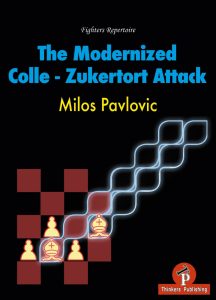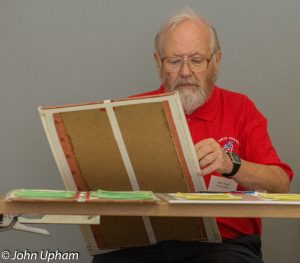
Grandmaster Milos Pavlovic was born in Belgrade in 1964 and was Yugoslav Champion in 2002. He is a well known theoretician specialising in opening theory and has written many chess books and magazine articles.

This is his third title in the “Modernized” series from Thinkers Publishing with a fourth on the Scotch Game being published on November 17th. We first reviewed a title in this series with The Modernized Caro-Kann from GM Daniel Fernandez.
As with every recent Thinkers Publishing publication high quality paper is used and the printing is clear. The book can easily be laid flat next to the board and does not require weights to prevent it from “self-closing” (a particular bugbear of ours !). Each diagram is clear and the instructional text is typeset in two column format, which, we find, enables the reader to maintain their place easily. Figurine algebraic notation is used throughout and the diagrams are placed adjacent to the relevant text and each diagram has a “to move” indicator.
The main content is divided into ten chapters of which the first six concern lines in which Black plays an early d5 (usually 1.d4 d5) and the remainder where Black does not (usually playing 1.d4 Nf6).
There is no index which, unfortunately, is a standard feature of Thinkers Publishing books. Also missing is a bibliography.
This is a repertoire book for the White player utilizing the undeservedly less popular Zukertort flavour of the Colle System. In the “CZ” System the c1 (Queen’s for the more mature reader !) bishop is developed to b2 rather than the c1 – h6 diagonal as in the Koltanowski flavour of the Colle System. Typically therefore White attempts to establish a structure of the sort :
and play for ideas such as Ne5, f4 Rf3, Rg3 and checkmating attacks involving the bishop pair. These are often similar to the famous Lasker – Bauer game of 1889.
On the other hand we have the possibly more familiar Colle-Koltanowski structure of :
and the main idea of the latter is to advance e4, e5 and the launch a fairly clockwork attack against Black’s kingside.
Both of these approaches have been served by books, videos and instructional DVDs of the “Winning with the X” sort with the most well known players of the Colle-Zukertort being Aaron Summerscale, Artur Yusupow, Susan Polgar and Vladimir Kramnik.
We have no intention of “spilling the beans” on all of the many and varied ideas presented by Pavlovic : you should buy the book and find out for yourself. However, as past players of the CZ ourselves we noticed interesting advice on the move order advised. The traditional move order in possibly the most challenging main line has (more or less) been :
1.d4 d5 2.Nf3 Nf6 3.e3 e6 4.Bd3 c5 5.b3 Nc6 6.0-0 Bd6 7.Bb2 0-0 8.Nbd2 leading to the following well-known, traditional position :
and David Rudel in his various evangelistic style CZ books advocated 8.Ne5 instead. In The Modernized Colle-Zuckertort we have this new move order :
1.d4 d5 2.Nf3 Nf6 3.e3 e6 4.Bd3 c5 followed by the provocative 5.0-0 ! giving us this position
which appears (well, it does!) to allow 5…c4!? This early castles move order is, in itself, modernizing and advocated by none other than the fourteenth World Champion, Vladimir Kramnik ! Other adherents of this move order include Artemiev, Vaganian and Romain Edouard, Editor of Thinkers Publishing.
To give you a feel for the book here is a sample
One idea that caught our eye was a recommendation of how to meet the Classical Dutch when played via
1.d4 e6 2.Nf3 f5
and you might expect a line to of the CZ to be recommended but you’d be quite wrong. We won’t spoil the surprise by telling you here ! Suffice to say this is not a formulaic “Play the CZ against everything and win” style of approach. You’d be disappointed if it was !
This book contain a veritable potpourri of new ideas and material plus strategical concepts for the White player in the CZ System. It offers much more than one of the cheesy “Play this Opening and you will win” style books that we are all familiar with. Having owned all (English Language) books and DVDs we would suggest that this is the most academic and the most appealing to players wanting to make the CZ a serious weapon of theirs. In the “club player opening book wars” this book redresses the balance with the recent splurge of London System books and videos.
Get this book and you will learn about middlegame, plans of attack and a wealth of other themes : highly recommended !
John Upham, Cove, Hampshire, 17th November, 2019

Book Details :
- Hardcover : 208 pages
- Publisher: Thinkers Publishing; 1 edition (July 29, 2019)
- Language: English
- ISBN-10: 9492510529
- ISBN-13: 978-9492510525
- Product Dimensions: 6.8 x 0.8 x 9.2 inches
Official web site of Thinkers Publishing
























